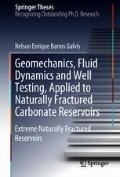Abstract
Naturally Fractured Carbonate Reservoirs (NFCRs) need to be classified based on the detection and evaluation of the dominant discontinuities, integrating dynamic and static parameters. Discontinuities can display flow behaviors and geological features, that may behave according to a variety of reservoir static-dynamic models. An integral classification is essential for optimum reservoir management and hydrocarbon production.
Access this chapter
Tax calculation will be finalised at checkout
Purchases are for personal use only
References
Aguilera, R. (2003). Geologic and engineering aspects of naturally fractured reservoirs. CSEG RECORDER, (pp. 44–49). (February).
Barros-Galvis, N., Villaseñor, P., & Samaniego, F. (2015). Analytical modeling and contradictions in limestone reservoirs: Breccias, vugs, and fractures. Journal of Petroleum Engineering. Article ID 895786. (Hindawi Publishing Corporation).
Bratton, T., Canh, D. V., Duc, N. V. et al. (2006). The nature of naturally fractured reservoirs. Oilfield Review.
Choquette, P. W., & Pray, L. C. (1970). Geologic nomenclature and classification of porosity in sedimentary carbonates. AAPG Bulletin, 54(2), 207–250.
Cinco-Ley, H. (1996). Well-test analysis for naturally fractured reservoirs. Journal of Petroleum Technology, 51–54. (SPE 31162, January).
Gilman, J. R., Wang, H., Fadaei, S. et al. (2011). A New Classification Plot for Naturally Fractured Reservoirs, paper CSUG/SPE 146580, presented at the Canadian Unconventional Resources Conferences, Calgary, Alberta, Canada, November 15–17.
Kohlhass, C. A. & Miller, F. G. (1969). Rock-compaction and pressure-transient analysis with pressure-dependent rock properties. Paper SPE 2563, Presented at 44th Annual Fall Meeting of the Society of Petroleum Engineers of AIME, Denver, Colorado, September 28–October 1.
Lucia, F. J. (2007). Carbonate reservoir characterization An integrated approach (2nd ed., pp. 26–67). Berlin: Springer.
Nelson, R. (2001). Geologic analysis of naturally fractured reservoirs (2nd ed.). New York: Gulf professional publishing/BP-Amoco.
Saidi, A. M. (1987). Reservoir engineering of fractured reservoirs (fundamental and practical aspects). Singapore: TOTAL Edition Presse.
Soto, R., Martin, C., Perez, O. et al. (2011). A new reservoir classification based on pore types improves characterization. Paper ACIPET TEC-86, Presented at the Congreso Colombiano del Petróleo, Bogotá. Colombia, November 22–25.
Streltsova-Adams, T. D. (1978). Well hydraulics in heterogeneous aquifer formations. Advances in Hydroscience, 11, 357–423.
Villaseñor-Rojas, P. (2003). Structural evolution and sedimentological and diagenetic controls in the lower cretaceous reservoirs of the cardenas field, Mexico. Ph.D. dissertation, Ecole Doctorale Sciences et Ingenierie De l’Université de Cergy-Pontoise (December).
Voelker, J. (2004). A reservoir characterization of Arab-D Super-K as a discrete fracture network flow system, Ghawar Field, Saudi Arabia. Ph.D. dissertation, Stanford University, Stanford (December 2004).
Author information
Authors and Affiliations
Corresponding author
Rights and permissions
Copyright information
© 2018 Springer International Publishing AG, part of Springer Nature
About this chapter
Cite this chapter
Barros Galvis, N.E. (2018). A Ternary, Static, and Dynamic Classification of NFCRs. In: Geomechanics, Fluid Dynamics and Well Testing, Applied to Naturally Fractured Carbonate Reservoirs. Springer Theses. Springer, Cham. https://doi.org/10.1007/978-3-319-77501-2_3
Download citation
DOI: https://doi.org/10.1007/978-3-319-77501-2_3
Published:
Publisher Name: Springer, Cham
Print ISBN: 978-3-319-77500-5
Online ISBN: 978-3-319-77501-2
eBook Packages: Earth and Environmental ScienceEarth and Environmental Science (R0)

